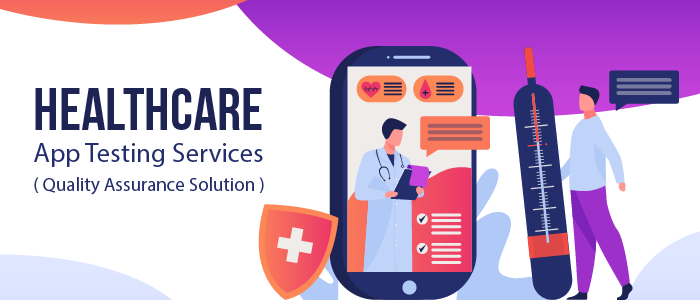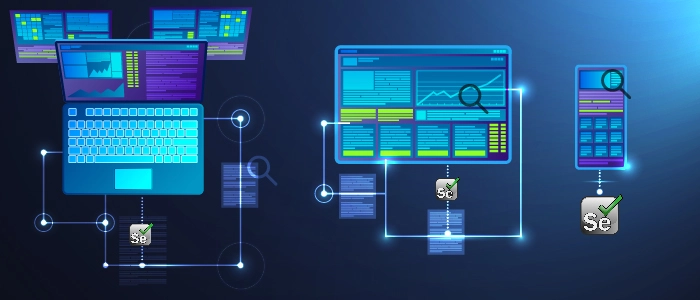Healthcare App Testing ensured via Quality Assurance for the Medical Sector
The healthcare sector is rapidly evolving today and technology plays a pivotal role in delivering efficient and reliable services. Healthcare apps have become essential tools for both patients and healthcare providers. To ensure the seamless operation or functioning of these apps and safeguard the well-being of users, quality assurance is very important.
Importance of QA for the Healthcare App
The significance of quality assurance in the healthcare app sector cannot be underestimated. Quality assurance processes ensure that these apps perform flawlessly, providing accurate information, secure data handling, and an intuitive user experience. Outsourcing services for quality assurance allow healthcare organizations to concentrate on their core competencies while experts take care of app quality.
The role of QA in healthcare apps is to ensure that the application meets the highest standards of quality and performance. Patient safety is a top priority, considering that healthcare apps often handle sensitive medical data. Flaws or inaccuracies can lead to misdiagnoses, incorrect treatment, or even life-threatening situations. Data integrity is another critical aspect. Patient health records must be accurate and secure, complying with strict regulatory requirements and guidelines. QA guarantees that data remains intact and confidential, minimizing legal risks.
Role of App Testing for Healthcare
Testing healthcare apps presents unique challenges, including regulatory compliance, security concerns, and the need for real-time data accuracy. Rigorous security testing is necessary to protect patient information, considering the high risk of data breaches in the healthcare industry.
Several testing methods are essential for healthcare applications. Functionality testing verifies that all app functions work correctly, from appointment scheduling to medication reminders. Security testing identifies and addresses vulnerabilities to protect patient data from unauthorized access. Usability testing ensures that the user interface is intuitive and user-friendly, contributing to a positive user experience.
To put it briefly, outsourcing quality assurance services for healthcare apps is a strategic move for organizations aiming to deliver reliable and secure digital health solutions. By prioritizing QA, healthcare providers can enhance patient safety and the organization’s integrity.
Dynamic XPath Best Practices for Stable Selenium Test Automation Solution
When considering Dynamic XPath in Selenium, Dynamic XPath in Selenium WebDriver, Stable XPath for dynamic web element software development and IT, mastering Dynamic XPath in Selenium is actually pivotal for robust test automation. Among the challenges testers and QA engineers face, handling Dynamic XPath in Selenium WebDriver is of paramount importance. This blog delves into essential best practices for creating Stable XPath for Dynamic Web Elements, that are tailored for QA engineers, QA managers, technical leads, and tech learners.
Unveiling the Challenge
Navigating Dynamic XPath in Selenium can be perplexing due to changing attributes, often leading to fragile automated tests that fail unpredictably. The dynamic nature of modern applications aggravates this issue, making stable automated tests a primary concern. Addressing this challenge necessitates strategic best practices that uphold the reliability of Selenium test automation.
Tailored Best Practices
Reliance on Relative XPaths: Favor relative XPaths over absolute ones. They anchor to specific elements, ensuring adaptability to changes.
Utilizing Unique Attributes: Prioritize selecting elements based on attributes that remain stable amidst changes, such as IDs or custom data attributes.
Dynamic Attribute Patterns: Leverage XPath functions like contains () or starts-with () to construct Stable XPath for Dynamic Web Elements.
Custom XPath Functions: Employ custom functions within XPath expressions, like concat() or translate(), for crafting Stable XPath for Dynamic Web Elements.
Avoiding Indexes: Steer clear of using indexes like in XPaths. Prioritize other attributes for element identification.
Data-Driven Approach: Implement data-driven testing to externalize dynamic values, enabling adaptable and Stable XPath for Dynamic Web Elements.
Benefits of Dynamic XPath for Selenium Test Automation
Reliable Tests: Stable XPath for Dynamic Web Elements ensures dependable tests, minimizing false results.
Reduced Maintenance: Robust XPaths reduce script updates, cutting maintenance efforts and enhancing efficiency.
Future-Proofing: Well-structured XPaths future-proof tests against evolving web elements.
Empowering Tech Learners: For tech learners entering software testing and QA, understanding these best practices for Dynamic XPath in Selenium is invaluable. It equips them with proactive strategies to tackle challenges, nurturing skills in an adaptable industry.
Conclusion
The software development and IT industry demand adept strategies for Dynamic XPath in Selenium WebDriver. By implementing these practices and creating Stable XPath for Dynamic Web Elements, QA professionals and tech learners can bolster their testing endeavors. This fortifies stable and efficient test automation, even in the dynamic landscape of modern software development.
Critical Role of System Testing in Achieving Quality Assurance
In the ever-evolving field of software development, ensuring the highest quality of a product is paramount. This is where System Testing emerges as the ultimate safeguard, serving as the final gatekeeper before software makes its way to the public domain. We understand the paramount importance of this phase and offer outsourcing solutions that elevate your software’s reliability through effective system testing.
System testing is not merely a formality; it’s a comprehensive process aimed at end-to-end verification, error identification, and defect prevention. Our expertise is dedicated to ensuring that your software meets the highest standards of quality, providing users with a seamless and satisfying experience.
Objectives of System Testing:
- Risk Reduction: System testing is strategically designed to mitigate risks associated with software deployment. By thoroughly testing the entire system, we identify potential vulnerabilities, ensuring a robust and secure end product.
- Defect Prevention: Unearth defects before they become critical issues. Our systematic approach to system testing identifies and addresses glitches, preventing them from reaching the end-user and ruining your software product’s reputation.
- Design Verification: To validate that the software aligns with its intended design and specifications, our meticulous testing processes guarantee that your software not only functions as intended but also adheres to the defined design principles.
Different Types of System Testing:
- Usability Testing: Enhances user satisfaction by ensuring an intuitive and user-friendly interface.
- Regression Testing: Guarantees that new changes do not adversely affect existing functionalities.
- Performance Testing: Validates the system’s responsiveness and stability under various simulated conditions.
- Functional Testing: Ensures each function of the software operates as expected without errors.
- Recovery Testing: Assesses the system’s ability to recover gracefully from failures.
- Migration Testing: Verifies smooth data transition between different environments.
- Hardware/Software Testing: Confirms seamless integration between hardware and software components.
Each type of system testing plays a crucial role in enhancing software quality, contributing to a positive user experience, and consolidating your software’s reliability in the market. To put it briefly, outsourcing quality assurance and testing services for software applications is a strategic move for organizations committed to delivering exceptional products.
Unveiling the Essentials and Advantages of Vulnerability Assessment and Penetration Testing
In the ever-evolving landscape of software development and Information Technology (IT), prioritizing the security and dependability of digital systems has become paramount. This is precisely where Vulnerability Assessment and Penetration Testing (VAPT) steps in. In this article, we’ll dive into the fundamental aspects of VAPT testing and spotlight the immense value it brings to the software development and IT industry.
Unraveling VAPT Testing:
Vulnerability Assessment and Penetration Testing (VAPT) software tools stand as a holistic strategy for pinpointing and addressing potential security vulnerabilities within software systems. It encompasses two pivotal components: vulnerability assessment and penetration testing.
Vulnerability Assessment Services: This initial phase entails utilizing automated tools to meticulously scan software applications and systems, seeking out known vulnerabilities. The objective is to unearth weaknesses that could potentially be exploited by malicious actors. Vulnerability assessment services facilitate the identification of common issues such as outdated software, mis-configurations, and weak authentication mechanisms.
Penetration Testing Providers: Also recognized as ethical hacking, penetration testing extends vulnerability assessment to the next level. Competent testers replicate real-world attacks to exploit identified vulnerabilities. The aim is to ascertain whether these vulnerabilities can be manipulated to gain unauthorized access, extract sensitive data, or disrupt system functionality. Penetration testing providers offer insights into the potential consequences of vulnerabilities and help to prioritize their rectification.
The Merits of VAPT Testing:
For professionals within the Software Development and IT industry, including Software Testers, QA Engineers, Developers, and Technical Leads, VAPT testing bestows a spectrum of invaluable advantages:
Proactive Vulnerability Detection: VAPT testing facilitates the identification of vulnerabilities in the developmental stages. This proactive approach curtails the risk of security breaches and avoids the expenses tied to resolving issues post-launch.
Augmented Security: By unearthing vulnerabilities and weak points, VAPT testing empowers organizations to fortify their security measures. This, in turn, safeguards sensitive data, customer information, and the organization’s standing.
Vulnerability Assessment Consulting Services: Organizations operating within industries subject to rigorous regulatory standards for data security and privacy can benefit from VAPT testing to meet compliance requisites. This precludes potential legal and financial ramifications.
Risk Mitigation: VAPT testing furnishes a lucid overview of an organization’s security stance. This information enables stakeholders to make informed decisions pertaining to risk mitigation strategies and resource allocation.
Elevated Software Quality: Infusing security testing into the development lifecycle also elevates the overall software quality. As vulnerabilities are addressed, the likelihood of software glitches and crashes declines.
Trust Establishment: In the software realm, trust reigns supreme. Demonstrating a staunch commitment to security through VAPT testing amplifies the trust of clients, associates, and end-users.
In the fiercely competitive realm of software development and IT, VAPT testing is not merely an option; it’s an imperative. By orchestrating exhaustive vulnerability assessments and penetration tests, organizations can bolster their systems against potential threats and deliver secure, top-notch software. Whether you’re a QA Engineer, QA Manager, Technical Lead, or an eager tech learner, assimilating the fundamentals of VAPT testing and embracing its value will invariably contribute to your triumph in the dynamic realm of technology.
Contact us for further details of your software testing requirements.
Elevating Customer-Centric QA: A Pinnacle in Experience Testing Excellence
Understanding the Essence of Customer Experience (CX):
Customer Experience plays a pivotal role in shaping the overall perception that consumers form about your brand through each interaction. This extends beyond mere functionality, encompassing intrinsic and latent qualities, and involves a thorough understanding of consumer behaviour. Every touchpoint, from the user interface of your website to the responsiveness of your app, contributes significantly to the overall customer experience. Leveraging Customer Experience Testing Services ensures that these interactions are thoroughly examined and optimized, guaranteeing a positive and seamless experience for your customers.
QA ensures that every aspect of your software or application functions seamlessly. From bug-free code to flawless user interfaces, QA ensures that customers experience a product that not only meets but exceeds their expectations.
Optimizing Customer Experience through User-Centric Design with QA Testing Services:
Quality Assurance (QA) plays a pivotal role in validating a user-centric design, ensuring interfaces are intuitive, navigation is smooth, and features are user-friendly. By conducting thorough testing from a user perspective, QA identifies and rectifies design flaws, contributing directly to a positive customer experience. The focus is on intuitive interfaces, user-friendly features, and fast, seamless navigation to enhance overall customer satisfaction.
Performance Optimization with Expert CX Testing Services:
Slow loading times and system glitches can deter positive customer experiences. QA is crucial for identifying and resolving performance issues, ensuring quick and reliable access to your product or service. Identify and rectify bottlenecks for swift loading times and seamless operations, contributing to a positive user experience.
Security Assurance into Quality Engineering & Assurance Services.
Integrate Security Assurance into Quality Engineering & Assurance Services to address rising cyber threats, a crucial factor for customer confidence. Quality Assurance (QA) plays a key role in identifying and mitigating security vulnerabilities, prioritizing security testing within Customer Service Quality Assurance for comprehensive Vulnerability Assessment and Penetration Testing (VAPT) and ensuring the protection of customer data, thus building trust in service quality.
Automation for Efficiency with Quality Assurance and Software Testing:
Use automation testing to streamline tasks, allowing QA teams to focus on complex scenarios and provide quicker feedback for developers. Ensure cross-device compatibility by testing applications across various platforms for a consistent user experience. Conduct comprehensive regression testing to identify unintended side effects of new features or updates, maintaining system integrity. By integrating these QA testing strategies, not only meet technical standards but also exceed user expectations, optimizing the customer experience. In the evolving landscape of software development and e-commerce, customer-centric QA testing is key to creating positive experiences and fostering brand loyalty.
Partner with us for top-notch service. Elevate your customer experience with quality testing.
CI/CD Integration’s Impact on Streamlining Quality Assurance in Software Testing
In today’s dynamic realm of software development, the demand for impeccable quality assurance has surged to unparalleled heights. As businesses ardently pursue the delivery of top-tier products and services to their clientele, the incorporation of continuous integration and continuous deployment (CI/CD) practices into the testing arena has emerged as an industry disruptor. In this enlightening blog post, we embark on a journey to unravel the extraordinary potential of CI/CD integration, a true game-changer, in optimizing product testing and fortifying the foundation of quality assurance.
Streamlined quality assurance testing platforms
CI/CD integration presents a seismic shift in the software quality testing solution landscape. It acts as a catalyst for enhanced efficiency, reducing bottlenecks, and streamlining the entire quality assurance testing platform. With CI/CD, software quality assurance testing services are no longer constrained by manual, time-consuming processes. It paves the way for automation, allowing teams to focus on strategic testing activities and creative problem-solving rather than repetitive, manual tasks.
Offshore Testing Quality Assurance Services Elevated
For organizations leveraging offshore testing quality assurance services, CI/CD integration offers a lifeline. It bridges geographical gaps by automating testing processes, ensuring that software quality is upheld consistently across borders. The ability to access real-time test results and collaborate seamlessly with global teams is a testament to the transformative potential of CI/CD integration. Organizations can now tap into the best talent worldwide without compromising on quality.
Empowering QA Automation with Cutting-Edge Tools
CI/CD integration empowers quality assurance teams with cutting-edge tools and continuous integration and continuous deployment tools. These tools automate test executions, perform code validations, and provide instant feedback, enabling rapid iterations and quick issue resolution. With the right QA automation software, teams can create robust test suites that cover a wide range of scenarios, ensuring comprehensive test coverage. This synergy between technology and human expertise results in an agile and responsive QA automation ecosystem.
CI/CD Integration’s Impact on Streamlining the Entire Process
The real marvel of CI/CD integration is its impact on streamlining the entire software development and testing process. It propels development teams towards a culture of iterative improvements, where every code change undergoes rigorous quality checks. This proactive approach to quality assurance reduces the risk of critical issues slipping into production, safeguarding the user experience.
The benefits extend beyond defect detection. CI/CD integration fosters a collaborative environment where developers, testers, and operations teams work in harmony. Communication is enhanced, and silos are dismantled. Developers gain a deeper understanding of testing, leading to the creation of code that is inherently more testable and resilient.
Conclusion
The integration of CI/CD practices into software testing has transcended industry norms and revolutionized the way quality assurance is approached. It offers a beacon of hope for organizations seeking to deliver high-quality products and services. As the software development landscape continues to evolve, embracing CI/CD integration becomes not just a strategic advantage but a necessity for businesses aiming to excel in the competitive digital era.
CI/CD integration is not a mere technological advancement; it’s a paradigm shift that places quality assurance at the forefront of the software development process. It empowers organizations to respond swiftly to market demands, reduce time-to-market, and, most importantly, deliver software that delights users. In a world where quality is the ultimate differentiator, CI/CD integration emerges as the catalyst for achieving software excellence.
For top-tier results in CI/CD Integration and QA, reach out to Softwaretestingservices today.
API Test Automation with Karate Framework improves Performance
Software development teams are likely to increase productivity & reduce cost, here raises the need for API integration. Software application today makes use of APIs for both functional & nonfunctional requirements, this powers internal structures and makes navigating of the software possible. Before API Integration QA engineers need to verify the APIs quality, if not the costs of the defects rack up higher than the testing. Recently to reduce repetitive and manual work developers adopt automation API testing tools to test fast & release fast.
API test Automation using Karate framework has become a top choice due to its easiness of integration into Continuous Integration and Continuous Deployment(CI/CD) pipeline and many other cool features. Karate Testing Framework allows even non developers to write API test quickly and ensure its compatibility. With this Karate Framework even tester without any programming background can perform tests more easily. It’s an open-source Behavior Driven Development (BDD) testing framework for API test automation, based on Cucumber and uses the Gherkin Syntax.
For instance, Manual Testing of an eCommerce like application for dead/Inactive API would be hard and unimaginable with huge nos of API collections. The Behavior Driven Development (BDD) approach and Gherkin style syntax of Karate Framework makes it easier to write API tests and execute tests with one-click and get through reports. Such API testing is done to test business logic, data responses and security, and performance bottlenecks.
Features & Benefits of API Test Automation using Karate Framework
- Karate features a multi-thread parallel execution
- It has detailed logs and reporting
- It simplifies automation testing with minimum lines of code.
- It provides information about unexpected or missing data or paths during software testing.
- One framework for cross-browser Web UI automation and Desktop automation testing
- QA and developer teams can work together with standard SCM or Git.
To find out more about our API testing expertise for your business application you can contact us. We support clients to deliver expected value beyond resources.
BeanShell Scripting for Web Application Performance Testing Services
In the world of software development, performance testing & load testing plays a crucial role in ensuring the robustness and scalability of applications. Load testing is a vital part of web and software development that ensures optimal performance for the end user. To effectively simulate real-world user scenarios and measure system perforfmance under various loads, developers often rely on scripting languages, Beanshell is one such language that supports Java syntax and extends it with scripting features like loose types, commands, and method closures.
In this blog post, we will explore Beanshell scripting features and how it can be leveraged for load testing purposes. Beanshell provides the user complete access to the API of the JMeter. The function of the JMeter enables the execution of customized BeanShell code at the time of sampler run.
Beanshell is one of the most advanced JMeter built-in components. It’s a light-weight scripting language that has syntax similar to Java. BeanShell allows you to write custom scripts that can be dynamically executed within your Java application. By analyzing performance bottlenecks and identifying areas of improvement, you can use BeanShell to customize and fine-tune your application’s behavior.
Before considering BeanShell scripting for performance improvement, it’s recommended to perform a thorough performance profiling of your web application. Identify the specific areas where performance optimization is needed. Profiling tools can help you pinpoint CPU-intensive methods, memory bottlenecks, or other performance issues that can be addressed through scripting.
By outsourcing your BeanShell testing needs to us you could empower your development team to focus on core activities and ensure the quality and reliability of the web application. We can design and execute a wide range of tests to uncover hidden bugs and ensure the stability and reliability of your application. Apart from this, we can test the web application thoroughly for various scenarios, including edge cases, negative scenarios, and real-world usage patterns.
To iterate quickly and fine-tune your code for better performance without interrupting the application’s operation consider partnering with software testing services provider and unlock the benefits of BeanShell which can deliver a robust and high-performing application to your users. Contact Us.
4 Key Stages: Power of Quality Assurance in Software Testing: Why It Matters More Than Ever
In software development, quality assurance (QA) plays a crucial role in ensuring that the final product meets the expected standards of quality. Essentially, QA involves in the process of monitoring and improving the software development life cycle (SDLC) to guarantee consistent and reliable results. This includes implementing various quality control measures, such as testing procedures and waste reduction techniques. QA helps to identify and resolve technical issues, as well as to ensure that the product adheres to regulatory and normative requirements. In this article, we will explore what is QA in software testing, how it works, and why it is of utmost importance for business that are seeking to produce high-quality software products.
The importance of quality assurance in software testing cannot be overstated. Without proper QA, the software product may be delivered with various bugs, errors, and defects, which can result in significant financial loss, loss of user trust, and damage to the company’s reputation. Therefore, it is essential to have a robust QA process in place to ensure that the software product is of high quality and meets the end-users’ requirements.
Quality assurance processes can be complex, but they can be simplified by using the Plan-Do-Check-Act (PDCA) model, which is a widely-used method for managing continuous process improvement. The PDCA model consists of 4 stages;
The planning Stage: It is the initial and most crucial step. During this stage, management or quality assurance specialists establish specific goals for producing high-quality products and develop feasible strategies to achieve those goals. Any potential issues can be anticipated at this stage.
The Execution Stage: It involves in implementing the processes identified in the previous stage. This involves creating policies, hiring employees, and implementing quality controls to execute the quality strategy.
The Checking Stage: It involves in comparing the actual test results to what was expected. This helps determine whether the products meet the necessary requirements. If they do, experts move on to the final stage. However, if they don’t, they return to the planning stage.
The Action Stage: In the Action stage, the organization takes action to improve the quality plan based on the outcomes of the previous stage. This involves modifying the quality strategy, implementing new practices, and continually monitoring the quality outcomes.
Quality assurance plays a critical role in software testing. It enables businesses to produce high-quality software products that meet or exceed the expectations of their customers. By implementing a successful quality assurance process, businesses can ensure that their software products are reliable, functional, and meet the desired quality levels. If you’re looking to improve the quality of your software products, then quality assurance is a must.
Looking to take your software testing process to the next level? Our team of experienced experts is here to help you achieve your quality assurance goals and ensure that your software products are of the highest quality. Contact us now to explore our QA services and start your journey towards success!











